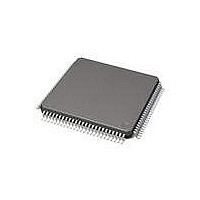71M6513-IGT/F Maxim Integrated Products, 71M6513-IGT/F Datasheet - Page 80

71M6513-IGT/F
Manufacturer Part Number
71M6513-IGT/F
Description
IC ENERGY METER 3PH 100-LQFP
Manufacturer
Maxim Integrated Products
Datasheet
1.71M6513H-IGTF.pdf
(104 pages)
Specifications of 71M6513-IGT/F
Mounting Style
SMD/SMT
Package / Case
LQFP-100
Program Memory Size
64 KB
Program Memory Type
Flash
Supply Current (max)
6.4 mA
Lead Free Status / RoHS Status
Lead free / RoHS Compliant
Available stocks
Company
Part Number
Manufacturer
Quantity
Price
Company:
Part Number:
71M6513-IGT/F
Manufacturer:
MAXIM
Quantity:
1 300
Company:
Part Number:
71M6513-IGT/F
Manufacturer:
Maxim Integrated
Quantity:
10 000
Part Number:
71M6513-IGT/F
Manufacturer:
MAXIM/美信
Quantity:
20 000
The accuracy of the RTC depends on the stability of the external crystal. Crystals vary in terms of initial accuracy as well as in
terms of behavior over temperature. The flexibility provided by the MPU allows for compensation of the RTC using the sub-
strate temperature. To achieve this, the crystal has to be characterized over temperature and the three coefficients Y_CAL,
Y_CALC, and Y_CAL_C2 have to be calculated. Provided the IC substrate temperatures tracks the crystal temperature, the
coefficients can be used in the MPU firmware to trigger occasional corrections of the RTC seconds count, using the
RTC_DEC_SEC or RTC_INC_SEC registers in I/O RAM.
It is not recommended to measure crystal frequency directly due to the error introduced by the measurement probes. A
practical method to measure the crystal frequency (when installed on the PCB with the 71M6513) is to have a DIO pin toggle
every second, based on the RTC interrupt, with all other interrupts disabled. When this signal is measured with a precision
timer, the crystal frequency can be obtained from the measured time period t (in µs):
Example: Let us assume a crystal characterized by the measurements shown in Table 61. The values show that even at
nominal temperature (the temperature at which the chip was calibrated for energy), the deviation from the ideal crystal
frequency is 11.6 PPM, resulting in about one second inaccuracy per day, i.e. more than some standards allow.
As Figure 29 shows, even a constant compensation would not bring much improvement, since the temperature characteristics
of the crystal are a mix of constant, linear, and quadratic effects (in commercially available crystals, the constant and quadratic
effects are dominant).
The temperature characteristics of the crystal are obtained from the curve in Figure 29 by curve-fitting the PPM deviations. A
fairly close curve fit is achieved with the coefficients a = 10.89, b = 0.122, and c = –0.00714 (see Figure 30).
Page: 80 of 104
A Maxim Integrated Products Brand
f
=
32768
Temperature Compensation and Mains Frequency Stabilization for the RTC
10
6
t
µs
Temperature [°C]
32768.5
32768.4
32768.3
32768.2
32768.1
32767.9
32767.8
32767.7
32767.6
32767.5
Deviation from
32768
Nominal
Figure 29: Crystal Frequency over Temperature
-50
+50
+25
-25
-50
0
Table 61: Frequency over Temperature
© 2005-2011 Teridian Semiconductor Corporation
-25
Frequency [Hz]
Measured
32767.98
32768.28
32768.38
32768.08
32767.58
0
3-Phase Energy Meter IC
Frequency [PPM]
25
Deviation from
71M6513/71M6513H
Nominal
-12.817
11.597
8.545
2.441
-0.61
DATA SHEET
50
AUGUST 2011












